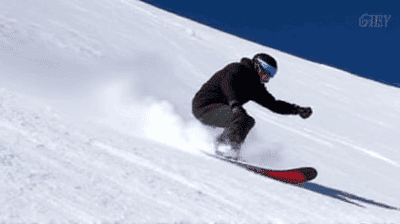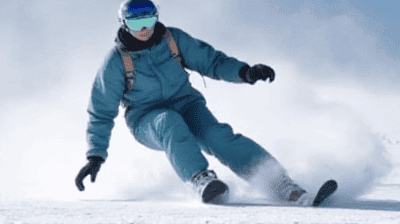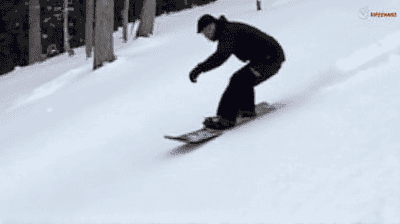80mph on a Snowboard: The Physics of Downhill Speed Riding



When it comes to extreme sports, few activities evoke the thrill of adrenaline quite like snowboarding. For many, the idea of speeding down a snowy slope at 80 miles per hour is both exhilarating and terrifying. As snowboarders hug the edge of control while racing down icy mountains, they experience a blend of speed, technique, and physics that shapes each descent.
Snowboarding emerged as a popular winter sport in the late 20th century, evolving from various board sports and inspired by skiing. Jack Burton, a surf enthusiast, and snowboard pioneer, created the first snowboards in the 1960s, laying the foundation for what would become a worldwide phenomenon. As the sport grew, so did the technology and techniques involved, transforming snowboarding into an extreme sport characterized by high speeds and daring maneuvers.
For many snowboarders, achieving high speeds is a thrilling aspect of the sport. High-speed riding provides:
Adrenaline Rush: The thrill of hurtling down a slope at breakneck speeds is an exhilarating experience that activates the body's fight-or-flight response, delivering an intense rush of adrenaline.
Sense of Freedom: Speed offers a unique sense of freedom. Riders often describe the exhilaration of gliding down a slope as a form of liberation, resulting in euphoric experiences.
Challenge and Achievement: Reaching high speeds requires a strong command of technique, control, and balance. Achieving and exceeding personal speed records contributes to a sense of accomplishment.

Understanding the physics involved in snowboarding requires knowledge of the fundamental forces acting on the rider:
Gravity: The primary force driving a snowboarder down a slope. As the rider descends, gravity pulls them towards the Earth, accelerating their speed.
Friction: Friction plays a critical role in snowboarding. While some friction is necessary for control, excessive friction can slow down the rider. The interaction between the snowboard and the snow surface affects speed and maneuverability.
Air Resistance: As riders pick up speed, they encounter increased air resistance. This force opposes gravity and can impact the rider's overall velocity. Understanding how to minimize air resistance is crucial for maximizing speed.
Newton's Laws of Motion: Sir Isaac Newton’s laws of motion directly apply to snowboarding. The first law emphasizes that an object in motion stays in motion unless acted upon by an outside force. This principle helps explain how momentum builds during a descent.
Acceleration and Speed: Acceleration is the rate of change of velocity. In snowboarding, the gravitational force causes the rider to accelerate down the slope. The steepness of the hill and the rider's body position can influence the rate of acceleration.
Trajectory Optimization: Riders can optimize their trajectory to harness gravity and reduce drag. A streamlined position—keeping the body low and centered—enables smoother descents and higher speeds.
Potential Energy: At the top of the slope, the rider possesses gravitational potential energy due to their elevation. As they descend, this energy converts into kinetic energy, allowing the rider to accelerate.
Kinetic Energy: Kinetic energy is the energy of motion. As speed increases, so does kinetic energy, defined by the equation KE = 0.5 * m * v^2, where m is mass and v is velocity. Understanding this equation helps athletes appreciate the relationship between speed and energy.
Conservation of Energy: In an ideal scenario (ignoring friction and air resistance), total mechanical energy remains constant. Potential energy converts to kinetic energy, enabling riders to maintain speed throughout their run.
Streamlined Posture: Adopting a crouched position with arms close to the body minimizes wind resistance and increases aerodynamic efficiency. This posture allows riders to cut through the air more effectively.
Lowering the Center of Gravity: Bending the knees and lowering the center of gravity enhances stability and control. This body positioning enables better handling of the snowboard.
Weight Distribution: Adjusting weight distribution on the board allows for sharper turns and better control at high speeds. Riders should focus on centering their weight over the board’s midpoint.
Choosing the Right Board: The snowboard's design significantly impacts speed. Factors to consider include board length, width, shape, and flex. Longer boards provide stability while allowing for higher speeds.
Waxing and Tuning: Proper maintenance of the board, including waxing and edge tuning, can significantly reduce friction and improve speed. A well-tuned board glides more smoothly across snow, enhancing overall performance.
Stance Width and Angles: Riders must find an optimal stance width and angle that allows for efficient weight distribution and balance. A slightly wider stance can improve stability at high speeds.
Building Speed: Riders should focus on building speed at the start of their descent. Momentum gained through gravity and technique translates to improved overall velocity.
Carving Techniques: Carving involves using the board's edges to create defined turns. This technique allows for maintaining speed while navigating around obstacles and turning efficiently.
Staying Loose: Remaining loose and relaxed helps riders absorb shocks from bumps and changes in terrain. A flexible body enables smoother transitions and better control during descents.

Snow Quality: The quality of the snow can greatly influence a rider's speed. Wet or slushy snow creates more friction, while powder offers a softer ride but can slow down the board.
Temperature Fluctuations: Temperature changes affect snow conditions. Colder temperatures can lead to icy surfaces, while warmer temperatures produce softer snow. Riders must adapt to these variances to maximize their speed.
Visibility Issues: Poor visibility due to fog, snow, or sun glare can hinder a rider's ability to navigate effectively at high speeds. Riders must remain vigilant and adjust their techniques accordingly.
Inequalities in the Snow: Bumps, moguls, and other terrain features can disrupt a rider's speed and balance. Mastering control over these obstacles becomes crucial for maintaining velocity.
Sharp Turns: Tight turns present challenges when reaching high speeds. Riders must adjust their technique to maintain control while navigating corners without losing momentum.
Jumping and Air: High-speed jumps can enhance the thrill but also add complexity to a rider's descent. Managing takeoff and landing effectively allows for a smooth transition back onto the slope.
Speed riding has developed a dedicated community, united by their passion for the thrill of snowboarding at extreme speeds:
Competitions and Events: Speed riding competitions, such as the FIS World Cup and various national championships, showcase athletes' skills and provide an arena for speed enthusiasts to push their limits.
Social Media Engagement: Platforms like Instagram and YouTube host vast communities of riders sharing their experiences, techniques, and highlights from high-speed runs. This engagement fosters camaraderie among riders and promotes inspiration.
Workshops and Training: Specialized workshops and training camps focus on helping snowboarders improve their skills, techniques, and safety measures when riding at high speeds.
Many noteworthy athletes have pushed the boundaries of speed riding, inspiring the next generation of snowboarders:
Shane McConkey: A pioneer in both skiing and snowboarding, McConkey’s innovative approach and daring feats have left a lasting impact on extreme sports.
Travis Rice: Renowned for his skills in backcountry snowboarding, Rice has pushed the limits of snowboarding and set records for high-speed descents worldwide.
John Jackson: A prominent rider known for his versatility, Jackson has incorporated speed riding into both freestyle and freeriding disciplines, showcasing the sport's dynamic nature.

Snowboarding at speeds of 80 mph poses inherent risks. Awareness of these risks is vital for ensuring safety:
High-Speed Falls: The potential for serious injury increases with speed, particularly when falling. Riders must develop techniques for falling safely to minimize injury risk.
Collision Risks: Navigating through crowded slopes can lead to collisions with other riders, trees, or obstacles, emphasizing the necessity of situational awareness.
Health Precautions: Riders should be aware of their physical limits and seek medical attention if they experience pain or injury while riding.
Protective Gear: Wearing appropriate gear, such as helmets, padded jackets, wrist guards, and knee pads, provides crucial protection against injury during high-speed runs.
Avalanche Safety Equipment: For backcountry riders engaging in speed riding, carrying avalanche safety gear, including beacons and shovels, is essential.
Regular Checks: Conducting regular checks of equipment, including boards and bindings, ensures riders have reliable gear ready for high-speed runs.
The field of snowboarding continues to evolve with innovations that improve safety and performance:
Advanced Materials: Technological advancements in board materials reduce weight while increasing durability and flexibility, enhancing overall performance.
Smart Technology: Wearable devices and smart helmets may soon provide real-time performance data, helping riders optimize their techniques for speed.
Virtual Reality Training: As virtual reality technology becomes more accessible, it could revolutionize training methods for aspiring speed riders by enabling simulated high-speed experiences.
The explosion of interest in snowboarding means that speed riding is likely to gain more traction in the coming years:
Youth Engagement: Increasing youth programs and initiatives aimed at promoting snowboarding can inspire a new generation of riders to pursue speed riding.
Global Reach: As snowboarding spreads worldwide, new cultures and regions may embrace speed riding, contributing to the sport's growth and development.
Environmental Awareness: Growing recognition of environmental issues will lead to more discussions about sustainable practices in skiing and snowboarding, with the aim of preserving snow-covered landscapes.
Speed riders often have exhilarating tales of their fastest descents and the unforgettable experiences that accompany high-speed riding:
Memorable Runs: Many riders recount their fastest runs—moments of pure adrenaline as they hit incredible speeds, feeling the wind rushing past them.
Overcoming Challenges: Stories of overcoming obstacles and personal fears resonate deeply within the speed riding community. The transformation from novice to seasoned rider is a journey full of learning and growth.
Camaraderie and Community: The sense of community among speed riders fosters strong friendships. Riders often share experiences, tips, and techniques, building lasting connections through their shared passion.
Snowboarding at speeds of 80 miles per hour pushes the limits of what is physically and mentally possible. The thrill of speed riding offers an extraordinary experience that combines physics, technique, and courage. From mastering the forces of gravity to perfecting body positioning, speed riders continually seek to improve performance, embracing the challenges associated with high-speed descents.
As the sport continues to evolve, so too will the techniques and technology that enhance the experience of speed riding. With an ever-expanding community of eager athletes, the adrenaline-fueled culture of snowboarding remains vibrant and alive, inspiring future generations to explore the exhilarating world of high-speed snowboarding.